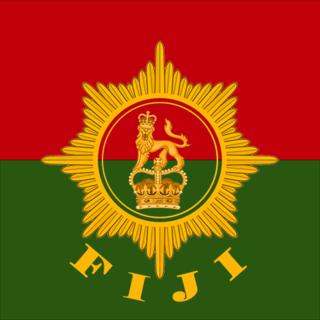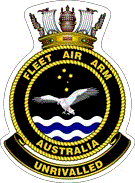
The Republic of Fiji Military Forces is the military force of the Pacific island nation of Fiji. With a total manpower of about 6,500 active soldiers and approximately 6,200 reservists, it is one of the smallest militaries in the world and the third largest in the South Pacific region. The Ground Force is organised into six infantry and one engineer battalions.

The Papua New Guinea Defence Force (PNGDF) is the military organisation responsible for the defence of Papua New Guinea. It originated from the Australian Army land forces of the territory of Papua New Guinea before independence, coming into being in January 1973 and having its antecedents in the Pacific Islands Regiment. The PNGDF is a small force, numbering around 3,600 personnel, and consists of a Land Element, an Air Element and a Maritime Element. It is a joint force tasked with defending Papua New Guinea and its territories against external attack, as well as having secondary functions including national-building and internal security tasks.

The Royal Australian Navy (RAN) is the naval force of the Australian Defence Force (ADF). The professional head of the RAN is Chief of Navy (CN) Vice Admiral Mark Hammond AM, RAN. CN is also jointly responsible to the Minister of Defence (MINDEF) and the Chief of Defence Force (CDF). The Department of Defence as part of the Australian Public Service administers the ADF.

The Royal Australian Air Force (RAAF) is the principal aerial warfare force of Australia, a part of the Australian Defence Force (ADF) along with the Royal Australian Navy and the Australian Army. Constitutionally the Governor-General of Australia is the de jure Commander-in-Chief of the Australian Defence Force. The Royal Australian Air Force is commanded by the Chief of Air Force (CAF), who is subordinate to the Chief of the Defence Force (CDF). The CAF is also directly responsible to the Minister for Defence, with the Department of Defence administering the ADF and the Air Force.

The Australian Defence Force (ADF) is the military organisation responsible for the defence of the Commonwealth of Australia and its national interests. It has three branches: the Royal Australian Navy (RAN), Australian Army and the Royal Australian Air Force (RAAF). The ADF has a strength of just over 89,000 personnel and is supported by the Department of Defence and several other civilian agencies.

The Royal Canadian Navy is the naval force of Canada. The navy is one of three environmental commands within the Canadian Armed Forces. As of February 2024, the RCN operates 12 Halifax-class frigates, 12 Kingston-class coastal defence vessels, 4 Victoria-class submarines, 2 Harry DeWolf-class offshore patrol vessels, 8 Orca-class patrol vessels, and several auxiliary vessels. The RCN consists of 8,400 Regular Force and 4,100 Primary Reserve sailors, supported by 3,800 civilians. Vice-Admiral Angus Topshee is the commander of the Royal Canadian Navy and chief of the Naval Staff.

Future planning of the Royal Navy's capabilities is set through periodic Defence Reviews carried out by the British Government. The Royal Navy's role in the 2020s, and beyond, is outlined in the 2021 defence white paper, which was published on 22 March 2021. The white paper is one component of the Integrated Review of Security, Defence, Development and Foreign Policy, titled as Global Britain in a Competitive Age which was published on 16 March 2021.

The Fleet Air Arm (FAA), known formerly as the Australian Navy Aviation Group, is the division of the Royal Australian Navy (RAN) responsible for the operation of aircraft. The FAA was founded in 1947 following the purchase of two aircraft carriers from the Royal Navy. FAA personnel fought in the Korean War and the Vietnam War, and participated in later conflicts and operations from host warships.
The Royal Australian Navy, although a significant force in the Asia-Pacific region, is nonetheless classed as a medium-sized navy. Its fleet is based around two main types of surface combatant, with limited global deployment and air power capability. However, in 2009, a white paper, Defending Australia in the Asia Pacific Century: Force 2030, was produced by the Australian government which set out a programme of defence spending that will see significant improvements to the RAN's fleet and capabilities.
Operation Resolute is the involvement of the Australian Defence Force (ADF) in Australian government efforts to prevent unauthorised entries to sovereign Australian territory. This has mainly taken the forms of: remote surveillance; air, sea and land patrols by ADF personnel; seizure of "suspected irregular entry vessels", and; locating/assisting people have entered Australia via such a vessel. Operation Resolute began on 17 July 2006 and consolidated a number of previous ADF operations, including Operation Relex.

The Attack-class submarine was a planned class of French-designed submarines for the Royal Australian Navy (RAN), expected to enter service in the early 2030s with construction extending until 2050. The project, which would have replaced the Collins-class submarines, began in 2007 as the Future Submarine program. In 2020 it was estimated to cost A$90 billion and would have been the largest and most complex defence acquisition project in Australian history.
The Andaman and Nicobar Command (ANC) is a integrated tri-services command of the Indian Armed Forces, based at Port Blair in the Andaman and Nicobar Islands, a Union Territory of India. It was created in 2001 to safeguard India's strategic interests in Southeast Asia and the Strait of Malacca by increasing rapid deployment of military assets in the region. It provides logistical and administrative support to naval ships which are sent on deployment to East Asia and the Pacific Ocean.
Tenix Defence was Australia's largest defence contractor with core capabilities in Aerospace, Land, Marine and Electronic Systems applications. BAE Systems announced its intention to acquire the company from Tenix in January 2008 and the acquisition was completed in June 2008 for A$775 million. BAE Systems Australia thus became Australia's largest defence contractor.

Defending Australia in the Asia Pacific Century: Force 2030 is an Australian Government white paper released on 2 May 2009. The publication seeks to provide guidance for Australia's defence policy and the Australian Defence Force (ADF) during the period 2009–2030.

The Arafura class is a class of offshore patrol vessels being built for the Royal Australian Navy (RAN). Initially proposed in the 2009 Defence White Paper and marked as procurement project SEA 1180, it was originally planned that 20 Offshore Combatant Vessels (OCV) would replace 26 vessels across four separate ship classes: the Armidale-class patrol boats, the Huon-class minehunters, the Leeuwin-class survey vessels, and the Paluma-class survey motor launches. Although having a common design, the ships would use a modular mission payload system to fulfill specific roles; primarily border patrol, mine warfare, and hydrographic survey. The 2013 Defence White Paper committed to the OCV project as a long-term goal, but opted in the short term for an accelerated procurement of an existing design to replace the Armidales, and life-extension refits for the other types. This resulted in the Offshore Patrol Vessel (OPV) project and the number of vessels reduced to 12. However, this was further increased to 14 when 2 further Mine Counter Measures variants were proposed under SEA 1905.
Security in the South Pacific has proved to be one of the most enduring of Australia's security concerns. It was the subject of Australia's first substantial strategic policy initiative, when in 1888 Alfred Deakin took his concerns about French intrusion into Vanuatu to London. Since then, the South Pacific has played an important role in Australian security thinking. Notably during the Second World War in the Pacific and through Australia's responsibilities as a colonial power in Papua New Guinea until that country's independence in 1975. Australia was regarded as having been quite detached from the Pacific Islands during the post colonial period. However this period, until the beginning of the 21st century, was marked by numerous small scale Australian Defence Force (ADF) operations in the region. The notable cases were in Vanuatu in 1980 and 1988 as well Fiji in 1987. The ADF also played an important role in peacekeeping missions in Bougainville during this period.
The National Security Strategy and Strategic Defence and Security Review 2015 was published by the British government during the second Cameron ministry on 23 November 2015 to outline the United Kingdom's defence strategy up to 2025. It identified key threats to the UK and the capabilities it required to address them.

The Hunter-class frigate is a future class of six heavy frigates for the Royal Australian Navy (RAN) to replace the Anzac class.












